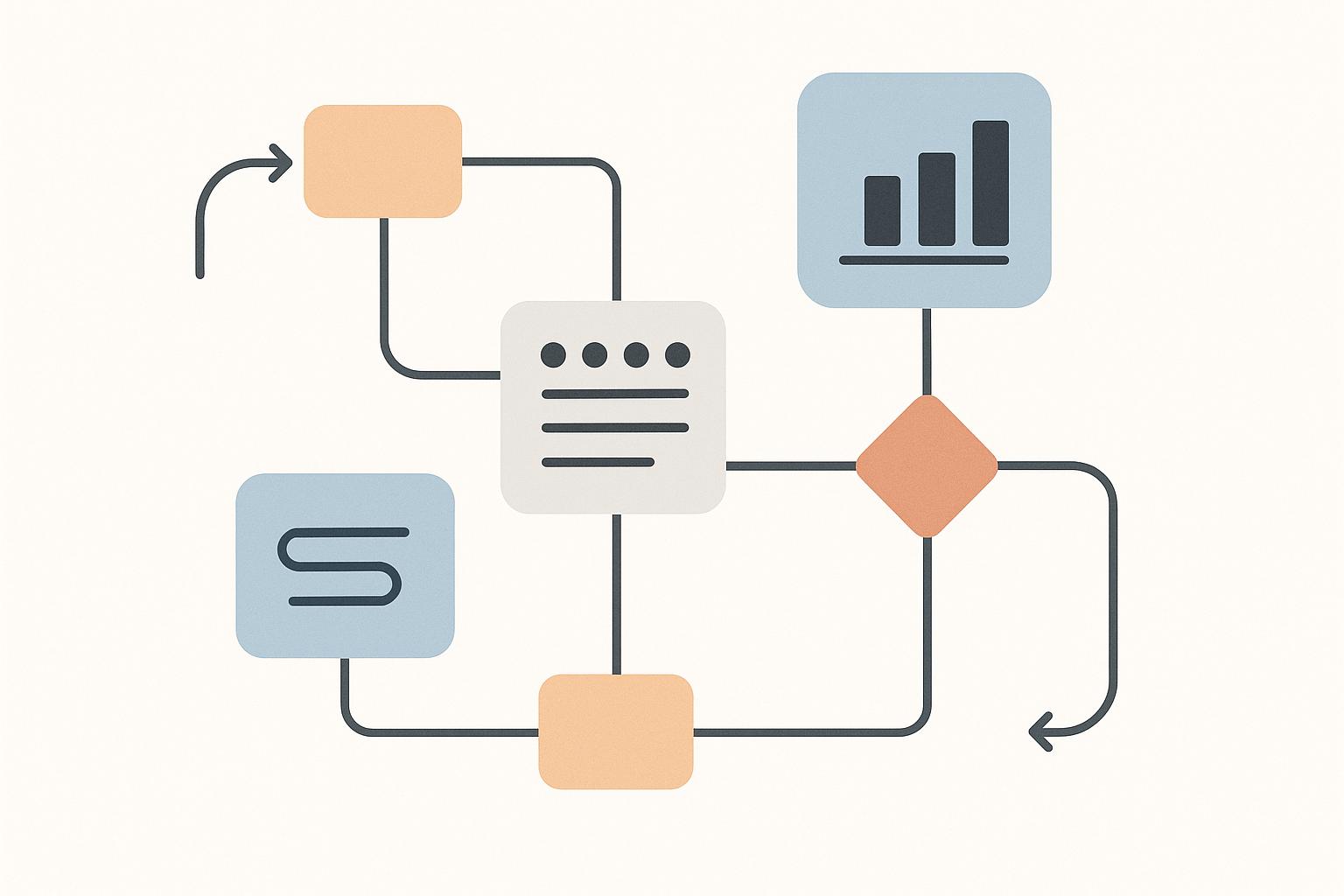Canopy API for Amazon Review Sentiment Analysis
Canopy API simplifies Amazon review sentiment analysis with real-time data access, flexible integration, and scalable pricing options for businesses.

Canopy API for Amazon Review Sentiment Analysis
Analyzing Amazon reviews is no small task. For businesses, understanding customer sentiment can unlock insights to improve products and stay competitive. But manually sorting through thousands of reviews? That’s not realistic. Enter Canopy API - a tool designed to simplify this process.
Here’s what Canopy API offers:
- Real-time data: Access up-to-date Amazon reviews for over 350 million products across multiple regions.
- Integration flexibility: Choose between REST or GraphQL endpoints for seamless development.
- Scalable pricing: Start free with 100 requests/month or pay $0.01 per request, with discounts for higher usage.
- AI-powered features: Get pre-processed insights to speed up sentiment analysis.
While Canopy API focuses on delivering raw review data, businesses will need their own sentiment analysis tools. Alternatives often include built-in scoring but may lack Amazon-specific features or real-time access.
If your priority is Amazon review analysis with minimal setup, Canopy API is worth considering. However, broader platforms might suit businesses targeting multiple data sources.
Sentiment Analysis of Amazon Reviews | Sentiment Analysis Python Tutorial | ML Tutorial| Simplilearn

1. Canopy API

The Canopy API simplifies Amazon review sentiment analysis by offering direct, real-time access to review data through both GraphQL and REST interfaces. This eliminates the hassle of managing custom Amazon scrapers, providing detailed product and review information that’s vital for sentiment analysis workflows.
Real-Time Data Access
With the Canopy API, businesses can tap into real-time Amazon review data for over 350 million products across 25,000+ categories. This ensures that sentiment analysis is based on the most up-to-date customer feedback, not outdated reviews.
The platform processes 10,000+ cache hits daily, consistently delivering fresh data. This allows businesses to monitor emerging trends, address product issues quickly, and stay ahead of customer sentiment shifts. Moreover, the API supports multiple Amazon domains - including the US, UK, Canada, Germany, France, and more - enabling businesses to analyze customer sentiment across various markets and regions.
Flexible Integration Options
Canopy API supports both REST and GraphQL endpoints, giving developers the flexibility to integrate the platform into their existing workflows.
- The REST endpoint (
https://rest.canopyapi.co/) offers a straightforward way to access data. - The GraphQL endpoint (
https://graphql.canopyapi.co/) allows for more precise data querying, enabling developers to fetch only the specific fields they need. This reduces bandwidth usage and processing demands, making it ideal for sentiment analysis tools.
The platform’s documentation and open-source examples make it easy to get started, whether you prefer the simplicity of REST or the customization power of GraphQL.
Built for Scale
Canopy API is designed to handle high volumes of data, making it suitable for everything from small projects to enterprise-level applications analyzing thousands of products daily.
Its pricing structure is equally scalable:
- Hobby Plan: Includes 100 free requests per month, ideal for testing workflows.
- Pay As You Go: Starts at $0.01 per request after the free 100, with discounts for higher usage tiers (10,000 and 100,000 requests).
- Premium Plan: Priced at $400+ per month, it includes 100,000 requests, with additional requests costing $0.004 each.
This tiered approach ensures businesses only pay for what they need, while maintaining reliable performance even during peak demand.
AI-Enhanced Insights
Beyond raw data, Canopy API offers AI-powered features that streamline sentiment analysis. These tools provide pre-processed insights, helping businesses uncover meaningful patterns in customer feedback more efficiently.
The platform’s AI capabilities go beyond simple data retrieval, offering contextual insights that improve analysis accuracy. By reducing the computational burden on client applications, these features ensure high-quality data and faster processing.
With its robust features and scalable options, Canopy API sets a high standard for sentiment analysis tools, paving the way for exploring alternative solutions in this space.
2. Other Sentiment Analysis API Solutions
A common challenge with many sentiment analysis APIs is the lack of detailed documentation, especially when it comes to processing Amazon review data. This makes it tricky to evaluate their capabilities in areas like data access, integration, scalability, and analysis. Without clear guidance, businesses may struggle to determine if a solution meets their needs.
For companies looking to automate sentiment analysis, it’s crucial to choose a provider that offers transparent documentation, dependable real-time processing, easy integration, and scalable performance. These factors ensure that the solution can handle large volumes of data efficiently while delivering accurate insights.
sbb-itb-d082ab0
Advantages and Disadvantages
When it comes to analyzing sentiment in Amazon reviews, businesses must weigh the pros and cons of different solutions. Canopy API, with its real-time access and integration options, offers a tailored approach designed specifically for Amazon data. Let’s dive into the benefits and trade-offs of this solution.
A standout feature of Canopy API is its Amazon-specific focus and real-time data access. It provides instant access to reviews, pricing, and sales estimates without the need for companies to maintain their own scraping infrastructure. This saves time and reduces operational complexity while allowing businesses to focus on interpreting the data rather than collecting it.
Another major advantage is its flexibility in integration. Canopy API supports both REST and GraphQL interfaces, complete with detailed documentation and open-source examples, making it easier for development teams to get started. Additionally, the scalable pricing model ensures that as usage grows, the cost per request decreases, which can be especially appealing for businesses planning to scale.
However, there’s a trade-off. While Canopy API excels in delivering raw review data, businesses must implement their own sentiment analysis tools to derive insights. This could require additional resources and expertise.
On the other hand, some alternative solutions provide broader platform coverage and often include built-in sentiment scoring and emotion detection. However, these options may require significant customization to handle Amazon’s unique data structure and frequent updates. Additionally, they often lack the real-time capabilities that Canopy API offers, which could be a drawback for businesses needing immediate insights.
Here’s a quick comparison of Canopy API and other solutions:
| Feature | Canopy API | Other Solutions |
|---|---|---|
| Real-time Amazon Data | Native real-time access | Requires custom development and upkeep |
| Integration Options | REST and GraphQL APIs with robust support | Typically REST-only; limited Amazon focus |
| Maintenance Overhead | Low – API handles data updates | High for custom scrapers; varies by provider |
| Built-in Sentiment Analysis | Provides raw data for analysis | Often includes pre-built sentiment scoring |
| Amazon-Specific Features | Tailored for Amazon review data | May need heavy customization |
| Scalability | Cost-efficient with lower per-request costs | Varies widely |
| Platform Coverage | Exclusive to Amazon data | Supports multiple platforms, less specialized |
Cost is another key factor to consider. Canopy API offers a free tier with 100 monthly requests, followed by a pay-as-you-go model at $0.01 per request. For premium users, costs drop to $0.004 per request with plans starting at $400 per month. While custom scraping solutions might appear cheaper upfront, their ongoing maintenance and development often lead to higher long-term expenses.
Ultimately, the right choice depends on your business needs. If your focus is on Amazon review analysis with minimal technical effort, Canopy API’s specialized features make it a strong contender. However, if you need a solution that spans multiple platforms or includes ready-to-use sentiment scoring, other options might be worth exploring, despite the added challenges of adapting them to Amazon’s data.
Conclusion
Analyzing Amazon reviews for sentiment can be a daunting task for U.S. businesses due to the sheer volume of data and its complexity. That’s where Canopy API steps in, offering real-time access to over 350 million Amazon products across more than 25,000 categories. This eliminates the need for companies to invest in building and maintaining intricate scrapers, saving both time and resources.
Another major advantage is how easily Canopy API integrates into existing systems. With a combination of REST and GraphQL APIs, detailed documentation, and open-source examples, development teams can skip the headaches of data collection and focus entirely on sentiment analysis. For businesses aiming to implement sentiment analysis quickly, this level of integration ensures they can get up and running without sinking excessive effort into infrastructure.
While Canopy API provides the raw review data, it’s designed to work seamlessly with AI and machine learning tools, enabling businesses to perform in-depth sentiment analysis. By simplifying data collection and offering flexibility, it empowers companies to integrate sentiment analysis into their workflows efficiently and effectively.
FAQs
How does real-time data from the Canopy API enhance Amazon review sentiment analysis for businesses?
The Canopy API offers real-time access to Amazon review data, giving businesses a powerful tool to collect and analyze customer feedback efficiently. This access helps companies uncover trends, gauge consumer sentiment, and make informed decisions to enhance product listings or refine marketing strategies.
By streamlining the way reviews are accessed and processed, the Canopy API not only saves time but also enables businesses to focus on insights that drive action - helping them maintain an edge in the ever-evolving e-commerce landscape.
What integration options does Canopy API offer, and how do they support various development needs?
Canopy API offers both REST and GraphQL options, giving developers the flexibility to choose the integration style that best fits their workflow. With these APIs, you can tap into real-time Amazon.com data, including product details, pricing, reviews, and more.
To simplify the integration process, Canopy API provides detailed documentation and open-source examples. These resources are designed to help developers hit the ground running and tailor their solutions effortlessly.
What is the pricing structure of Canopy API, and how does it support business growth?
Canopy API provides a pricing structure designed to suit businesses of all sizes. Each account starts with a free trial, offering 100 free requests per month to help you explore the platform. Once you exceed the free tier, the "Pay As You Go" plan charges $0.01 per additional request, keeping it simple to adjust as your needs expand.
For businesses with higher usage, volume discounts are available once you hit 10,000 and 100,000 requests per month. If your needs are even greater, the "Premium" plan offers 100,000 requests for $400 per month, with any extra requests costing $0.004 each. This pricing model ensures you pay only for what you use while supporting your business as it grows.